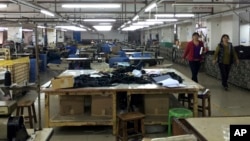There are an increasing number of protests in China, driven by the country’s slowing economy labor activists say. In some cases protesters have been able to force compromises by their bosses on wages and benefits.
The China Labor Bulletin - which tracks disputes - found that there were nearly 1,400 strikes in 2014, and the number of protests has risen even higher in the first two months of 2015.
“We record strikes and collective work protests as and when they happen, and over the last couple of months we’ve been recording 200 incidents a month, on average,” explained Jeffrey Crothall, a researcher with China Labor Bulletin’s Hong Kong office.
The group recorded 569 protests in the fourth quarter of last year - three times more strikes than during the same period in 2013. The figure also indicates a sharp increase from 2011, when there were only 185 documented labor protests during the entire year.
China’s economy has slowed, expanding by just 7.4 percent in 2014, the slowest pace in some 20 years. Authorities warned the public that the country is entering a phase of less rapid, but “higher quality” growth.
Social media boost
The strikes have spread rapidly via social media among workers primarily located between Guangdong, Jiangsu, Shandong and Henan provinces. The majority of protesters are demanding higher wages, back pay and greater benefits and pensions.
“... In most cases people are asking for what the factory owes them in respect to wages and arrears, social insurance payments, the housing fund,” explained William Nee, a China researcher for human rights group Amnesty International.
“So all of these things are really more factory specific. Or in some cases people are protesting to the government to get the factory to pay them. So these are protests that don’t really have a political dimension to them. They are more focused on employer relations.”
In 1995 China enacted a labor law which granted all workers the right to a wage, rest periods, no excessive overtime and the right to carry out group negotiations. Rapid economic growth in the years since has lifted millions out of poverty, but as the economy cools wages could stagnate and unemployment could rise, and many could start blaming the government.
Authorities in Beijing, hoping to push local authorities to address the situation, last month issued a notice to local governments to make improving labor relations an “urgent task.” The directive said officials will work to ensure employees are paid on time and in full, launch programs to provide better labor protections for rural migrant workers, and call on employers to improve workplace safety.
Impact of slowdown
But those efforts may be unable to reverse the painful effects of the economy’s broader slowdown.
“So starting in February the economy has been on a major downward trend, much more so than many economists realize," said Shaun Rein, head of China Market Research. "And the decline is really focused on unemployment, not so much GDP growth, which I think is really an ok number. But what you’re seeing in the factory area is some of the smaller and weaker factories having to squeeze margins."
Rein added China’s labor markets are weakening in both urban and rural areas among blue and white collar workers, which could threaten social stability. Although many of those participating in the labor protests have been detained, few have been criminally prosecuted.











